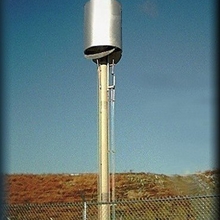 Theoretical by-products of combustion & destruction efficiency
Theoretical by-products of combustion & destruction efficiency
The Theoretical temperatures of combustion within the flame cone, based on the combustion of 300 Btu/ft³ to 550 Btu/ft³ LHV typical landfill gas, are between 1400°F and 1600°F. While combustion in these types of flares is not completed until the flame has been fully diluted in atmospheric air, the theoretical by-products of combustion are assumed to be a maximum of 0.068 lb/MMBtu Nox, and 0.37 lb/MMBtu CO. The overall, average weighted destruction efficiency of such a device is theoretically a minimum of 98% VOC’s, or a maximum of 20 ppm non-methane organics (NMOC’s), evaluated as hexane and corrected to 3% oxygen. This theoretical destruction efficiency is supported in an EPA “Air Pollution Technology Fact Sheet” entitled EPA-CICA Fact Sheet – Flare. While sulphur compounds (generally H2S) are very efficiently oxidized (generally into SOx compounds), please note that candlestick flaring systems neither generate nor destroy sulphur.
The above theoretical performance of PEI flares is only valid if the devices are operated in accordance with the design limitation(s) under which they were provided.
The actual “in field” emissions from a candlestick (utility) flare cannot be accurately measured or monitored because of the immediate dilution of the flame cone to atmosphere, and the continual movement of the central flame cone due to air and wind currents.
For verifiable, field measured by-products of combustion, and verifiable field measured destruction efficiencies, use of a PEI Enclosed Ground Flare is recommended.
